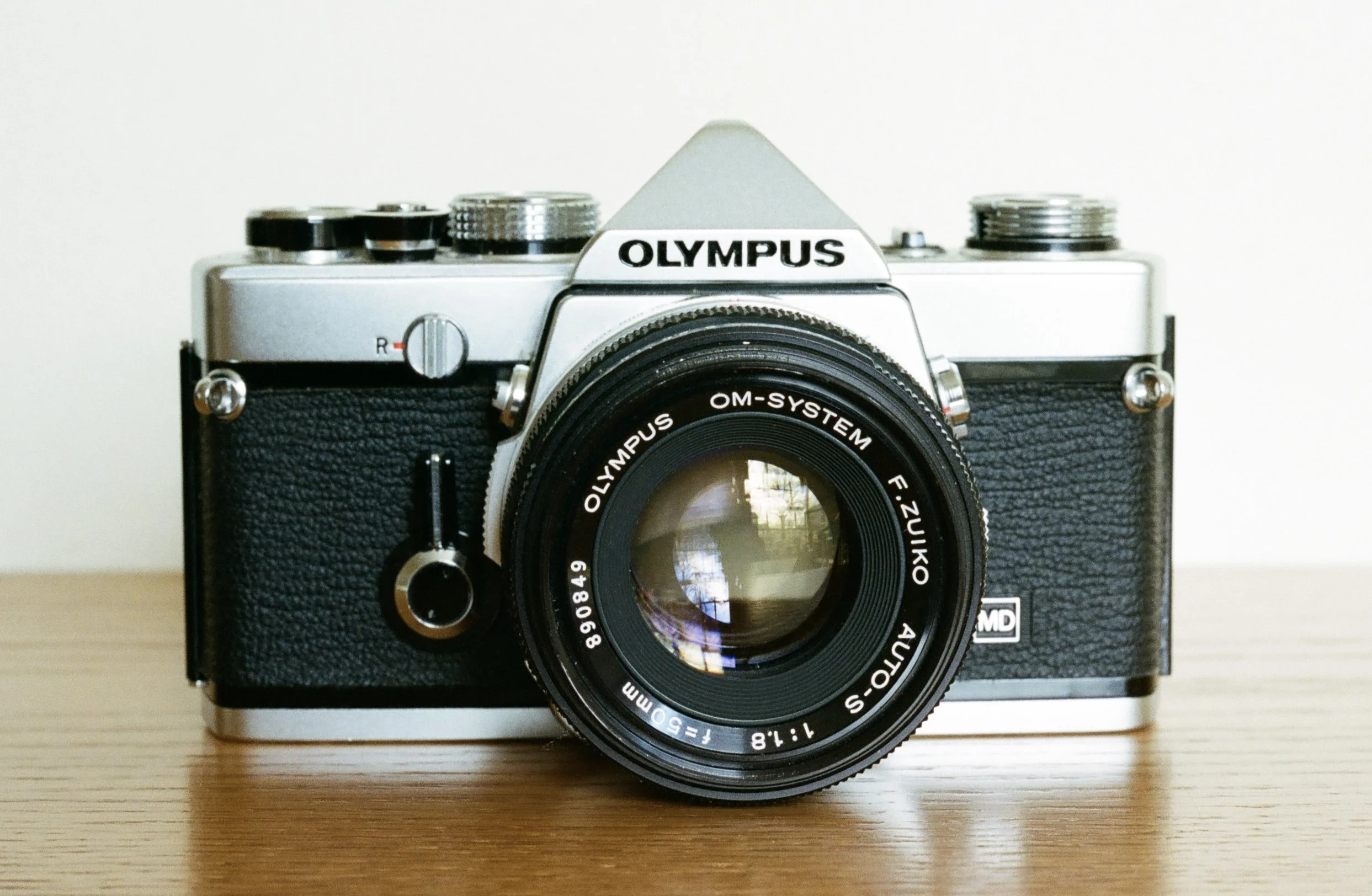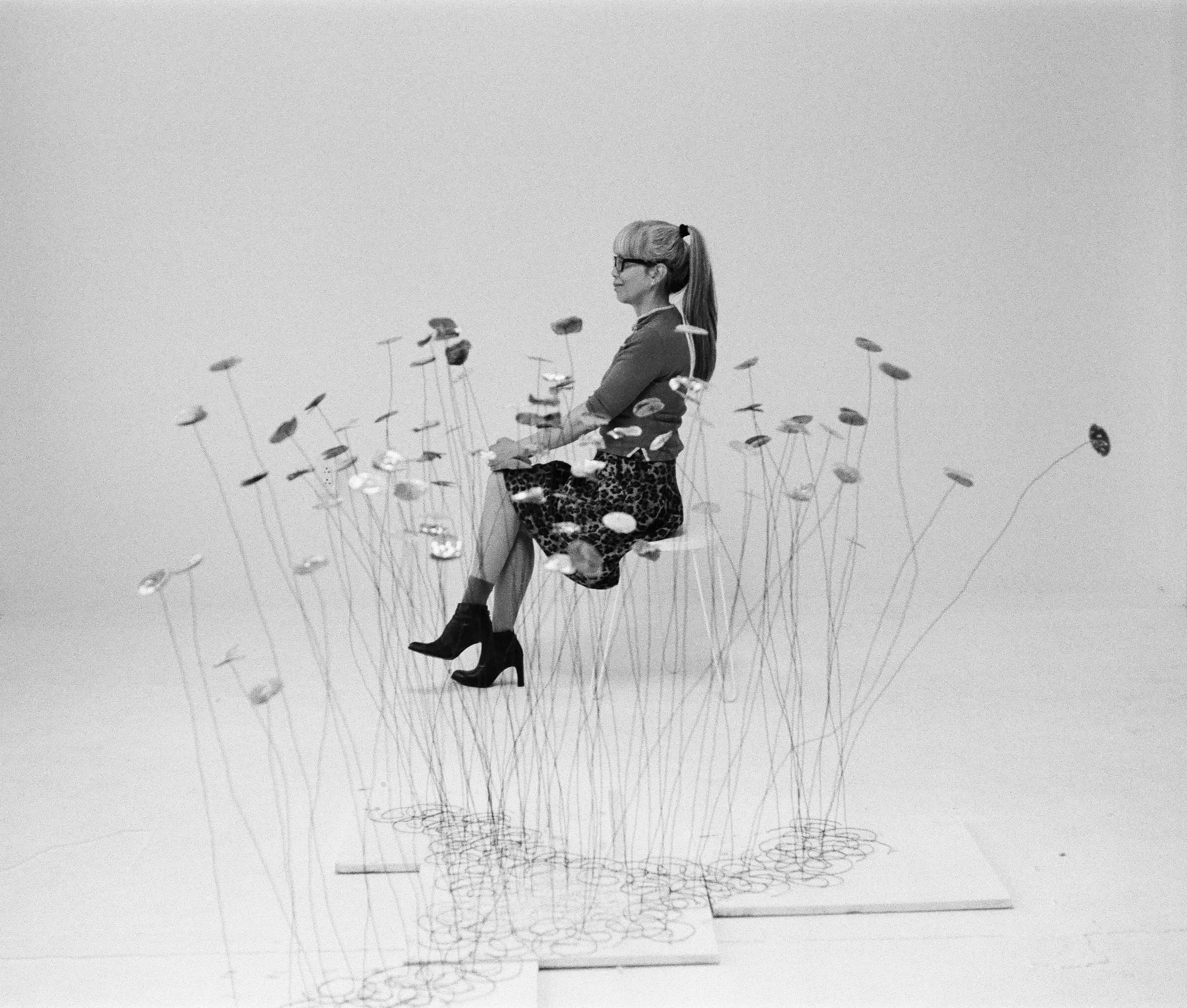Olympus OM-1
Trendy when new, with a dedicated following today.
Olympus OM-1 with 50mm f/1.8 F. Zuiko lens. (Color photos of the camera were made with a Nikon F, 55mm f/3.5 Micro-Nikkor-P.C, and Portra 400.)
An immediate big success
‘Olympus hit a home run with the OM-1 in 1973. Almost overnight, the OM-1 became the star of the entire industry’ (Gustavson, 2011). The OM-1 was ‘very small, very light, very quiet and quickly became very trendy’ (Matanle 1996).
Artomatic Washington, D.C. Olympus OM-1, 50mm f/1.8 F.Zuiko, Tri-X, 2024.
Design
The Olympus OM-1 is an all-mechanical, manual exposure camera. The battery is only used for the meter. I leave it out and use a hand-held meter or the sunny 16 rule.
The OM-1 really is small and light (as mentioned above). But that’s not its only appealing feature. It has all-around excellent ergonomics including a large and bright viewfinder with a split image, and a lot of style. I like that the shutter speed control is a collar around the lens mount, similar to the Nikkormat and the Hasselblad.
I also like the detachable hot shoe, which I promptly detached for a cleaner look.
Olympus OM-1 with 50mm f/1.8 F. Zuiko lens.
The design team
The OM-1 design team was led by mechanical engineer Yoshihisa Maitani (Pritchard, 2014). Maitani was featured in Olympus advertisements, which helped make him the second best known 35mm camera design engineer after Oskar Barnack, the inventor of the Leica.
Who was the chief design engineer of other Japanese cameras? They seem to have been anonymous ‘salarymen’. For the Nikon F, the only design credit the company provides is, ‘the exterior of [the] Nikon F was designed by Yusaku Kamekura, a graphic designer’ (Nikon Corporation, Camera Chronicle).
Long (2018), in his book-length study of Nikon, does not name the Nikon F’s chief design engineer. He does, however, credit Nikon F graphic designer Kamekura (p. 55) and Olympus OM-1 chief engineer Maitani (p.99).
Barcelona-style chair Columbia, Md. Olympus OM-1, 50mm f/1.8 F.Zuiko, Tri-X, 2024.
A cult-like following
In the 1970s camera market, the Olympus OM-1 was not positioned at the Nikon F or F2 level but it was upscale, distinctive, and popular. It developed a cult-like following that endures today, kind of like the Rollei 35.
‘So devoted are followers of the OM-1 series of cameras that it is almost politically incorrect to say anything against Olympus in public’ (Matanle, 1996).
Artomatic Washington, D.C. Olympus OM-1, 50mm f/1.8 F.Zuiko, Tri-X, 2024.
Using the OM-1
I can understand why this camera is popular. It really is a joy to use. I haven’t had this one for very long but anticipate putting a lot of film through it.
Artomatic Washington, D.C. Olympus OM-1, 50mm f/1.8 F.Zuiko, Tri-X, 2024.
Maintenance and repair
Maintenance not yet needed, but it’s pretty new to me at this point.
Caffè macchiato. My favorite way to make coffee. Olympus OM-1, 50mm f/1.8 F.Zuiko, Tri-X, 2024.
References / further reading
Camera manual: orphancameras.com
More references:
Gustavson, T. 2011. 500 Cameras: 170 Years of Photographic Innovation. New York: Fall River Press. The 500 cameras are from the George Eastman House Technology Collection, Rochester, N.Y. The Olympus OM-1 is on p. 278.
Hunt, B. 2024. Film Camera Zen: A Guide to Finding the Perfect Film Camera. Los Angeles: Chronicle Chroma.
This camera is featured on pp. 138-1239. “The Olympus OM-1 (and later variants) is the sort of camera you come to when you have been shooting film for a while and want to take yourself to the next level.”
Karlsten, E. (text), V. Hasselblad, P. Halsman, L. Nilsson, et al. (photos). 1981. Hasselblad. Stockholm: Gullers International.
In my discussion of renowned 35mm camera design engineers, I mentioned Barnack (Leica) and Maitani (Olympus). Not Victor Hasselblad, as his camera was medium format, not 35mm. In this book, Hasselblad is described as somewhat more of a visionary and manager than designer — creating the idea and performance specification for the Hasselblad camera and then managing his team to deliver it. He had the ability to ‘attract talented employees and to inspire them to share his own enthusiasm’ (pp. 22, 35).
Long, Brian. 2018. Nikon: A Celebration, 3rd ed. Ramsbury, England: Crowood Press.
McKeown, J.M. and J.C. 1996. McKeown’s Price Guide to Antique and Classic Cameras, 1997-1998. Grantsburg, Wis.: Centennial Photo.
Matanle, I. 1996. Collecting and Using Classic SLRs. New York: Thames and Hudson.
Nikon Corporation. Camera Chronicle: Development of Nikon F. https://imaging.nikon.com/imaging/information/chronicle/history-f/ accessed May 10, 2025.
This includes, ‘the exterior of Nikon F was designed by Yusaku Kamekura, a graphic designer’. The chief design engineer remains anonymous, in contrast to Olympus, where the work of OM-1 chief engineer Yoshihisa Maitani achieved international renown.
Pritchard, Michael. 2014. A History of Photography in 50 Cameras. Buffalo, N.Y.: Firefly Books. The Olympus OM-1 is camera no. 40.






